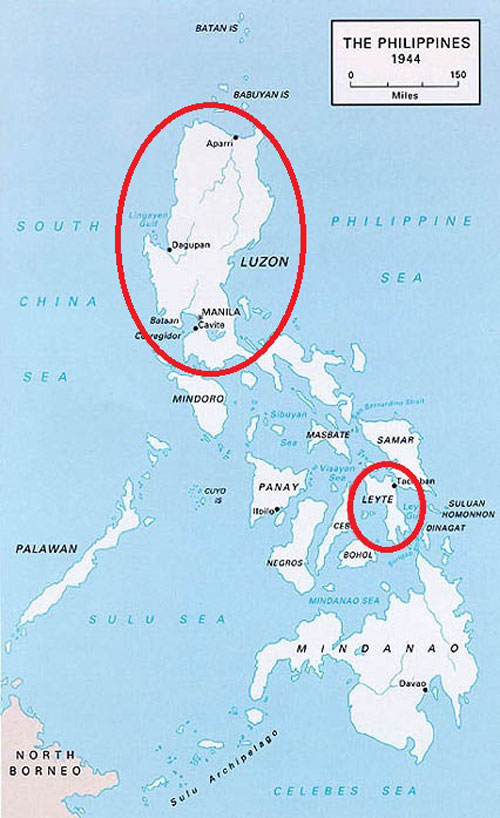(December 15, 1944 – July 4, 1945)
In December 1944, US troops were deployed to the northern Philippine island of Luzon, the largest island in the archipelago and the headquarters of Japanese forces in the Philippines. The main objective was the city of Manila, the capital of the island nation, with a population of nearly 800,000. Manila was central to Luzon, which in turn was central to the Philippines as a whole. Dominating the island would greatly weaken Japan’s ability to attack Allied forces.
Once a path was cleared to Manila, American forces found themselves engaged in a different kind of warfare as they fought their way through the city, which was virtually destroyed in the war. In addition to the many dangers of urban warfare, American forces also faced the threat of Japanese kamikaze planes, a practice of suicidal attacks that the Japanese had put into place in a desperate offensive measure after their defeat at Leyte. American forces would then move on to secure Manila Bay, which entailed the retaking of both the Bataan Peninsula and Corregidor, a small island at its southern tip.
The campaign began with the seizure of Mindoro, an island south of Luzon that would serve as a base for the main invasion. On January 9, US troops landed at Lingayen Gulf on the northwest coast of Luzon. From there they would continue on to confront Japanese forces in northern and southern Luzon.
In northern Luzon was the Shobu Group, the majority of Japanese forces under General Tomoyuki Yamashita, commander of Japanese land forces in the Philippines. In southern Luzon was the Shimbu Group, a smaller group defending the south. Even after the Japanese surrendered Luzon on August 15, the remainder of these forces remained at large on the island.
Both sides suffered considerable casualties. Japan lost nearly all of its 230,000 military personnel on the island. The American Sixth and Eighth Armies lost more than 10,300 troops killed in ground combat, with another 36,550 wounded in action. Noncombat casualties numbered more than 93,000, including 260 deaths, mostly due to disease. Approximately 100,000 civilians died in Manila alone.
The Military Intelligence Service (MIS) soldiers at Luzon – more than 100 arriving from ATIS (Allied Translator and Interpreter Section) – took part on the battlefield as well as conducted linguistic work. Some translated captured documents and maps, while others interrogated thousands of POWs. The Nisei were often themselves in danger of being mistaken for Japanese Imperial Army soldiers by the local population.
Among the many American soldiers who fought bravely during the Luzon campaign was Private Kenji Uyesugi, who helped negotiate the release of 275 women and children held hostage by the Japanese at Santo Tomas University in Manila in early February, and Technician Third Grade William Ishida, who earned a Silver Star for his part in the fight to release the nearly 3,800 civilians interned at the University.
While Manila was secured on March 4, the fighting in Luzon continued for several months between American soldiers and retreating Japanese forces. Then, the Nisei helped the Counter Intelligence Corps (CIC) with processing suspected war criminals. They also participated in the September 3 surrender and later trial of General Tomoyuki Yamashita, commanding general of the Japanese Imperial Army in the Philippines.
Footnotes
- 1Dale Andrade, “Luzon: The US Army Campaigns of World War II,” US Army Center of Military History, last updated October 3, 2003, accessed January 16, 2015.
- 2Ibid.
- 3Ibid.
- 4The American Experience: MacArthur, “The Battle for Manila (February – March 1945),” PBS.org, accessed on January 16, 2015.
- 5James C. McNaughton, Nisei Linguists: Japanese Americans in the Military Intelligence Service during World War II (Washington, DC: US Army Center of Military History, 2006), p. 334.
- 6Ibid, p. 335.



